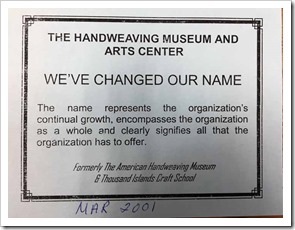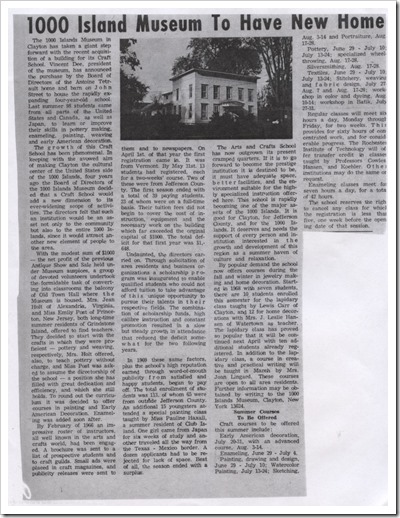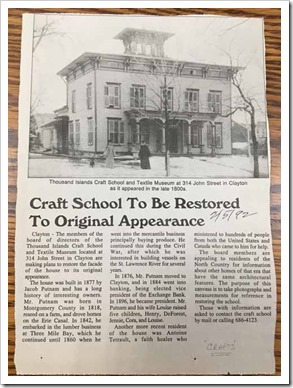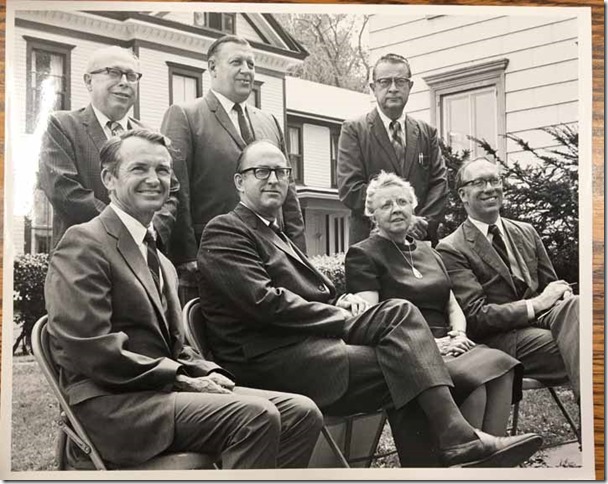It all began at the Thousand Islands Museum, then located in what is today the Clayton Opera House. Yes, three of the major museums in the North Country began under the auspices of the Thousand Islands Museum. Today they are the Thousand Islands Museum, the Antique Boat Museum, and the Thousand Islands Arts Center ~Home of the Handweaving Museum.
So, the first place I visited was the Thousand Islands Museum at 321 State Street in Clayton, NY. Going there is always a favorite excursion. This time, I went with a purpose; to look up the history of the Thousand Islands Arts Center. The Museum has three large binders, filled to the brim with clippings and photographs.
 Several articles caught my eye – most published by the “Thousand Islands Sun”, in the 1970s.
Several articles caught my eye – most published by the “Thousand Islands Sun”, in the 1970s.
 Synopsis: Binder page, Thousand Islands Craft School
Synopsis: Binder page, Thousand Islands Craft School
Started in 1966 on the Balcony of the old Town Hall with 35 students taking 10 classes with Emily Post as the Dean of the School. Moved from TI Museum and opened at 314 John Street in the Antoine Tetrault house in 1970.
They received Provisional Charter, 9/23/83, and Absolute Charter 4/27/90.
Changed their name to The Handweaving Museum and Art Center in 2002.
Today they are the Thousand Islands Arts Center ~Home of the Handweaving Museum.
TI Sun Article, 1970 – “1000 Island Museum to Have New Home”
The 1000 Islands Museum in Clayton has taken a giant step forward with the recent acquisition of a building for its Craft School. Vincent Dee, president of the museum, has announced the purchase by the Board of Directors of the Antoine Tetrault home and barn on John Street to house the rapidly expanding four-year-old school. Last summer 98 students came from all parts of the United States and Canada, as well as Japan, to learn or improve their skills in pottery making, enameling, painting, weaving and early American decoration.
The growth of this Craft School has been phenomenal. In keeping with the avowed aim of making Clayton the cultural center of the United States side of the 1000 Islands, four years ago the Board of Directors of the 1000 Islands Museum decided that a Craft School would add a new dimension to its ever-widening scope of activities. The directors felt that such an institution would be an asset not only to the community but also to the entire 1000 Islands, since it would attract another new element of people to the area.
With the modest sum of $1000 — the net profit of the previous Antique Show and Sale held under Museum auspices, a group of devoted volunteers undertook the formidable task of converting into classrooms, the balcony of Old Town Hall where the Museum is housed. Mrs. Jean Holt of Alexandria, Virginia, and Miss Emily Post of Princeton. New Jersey, both long-time summer residents of Grindstone Island, offered to find teachers. They decided to start with the crafts in which they were proficient — pottery and weaving, respectively. Mrs. Holt offered, also, to teach pottery without charge, and Miss Post was asked to assume the directorship of the school — a position she has filled with great dedication and efficiency, and which she still holds. To round out the curriculum, it was decided to offer courses in painting and Early American Decoration. Enameling was added soon after.
By February of 1966, an impressive roster of instructors, all well known in the arts and crafts world, had been engaged. A brochure was sent to a list of prospective students and to craft guilds. Small ads were placed in craft magazines, and publicity releases were sent to them and to newspapers. On April 1st of that year the first registration came in. It was from Vermont. By May 31st. 13 students had registered, each for a two-weeks’ course. Two of these were from Jefferson County. The first season ended with a total of 39 paying students, 23 of whom were on a full-time basis. Their tuition fees did not begin to cover the cost of instruction, equipment and the necessary work on the building which far exceeded the original capital of $1000. The total deficit for that first year was $1,648.
Undaunted, the directors carried on. Through solicitation of area residents and business organizations, a scholarship program was inaugurated to enable qualified students who could not afford tuition to take advantage of this unique opportunity to pursue their talents in their respective fields. The combination of scholarship funds, high caliber instruction and constant promotion resulted in a slow but steady growth in attendance that reduced the deficit somewhat, for the two following years.
In 1969, these same factors, plus the school's high reputation earned through word-of-mouth publicity from satisfied and happy students, began to pay off. The total enrollment of students was 113, of whom 65 were from outside Jefferson County. An additional 15 youngsters attended a special painting class taught by Miss Pauline Haxall, a summer resident of Club Island. One girl came from Japan for six weeks of study and another traveled all the way from the Texas - Mexico border. A dozen applicants had to be rejected for lack of space. Best of all, the season ended with a surplus.
The Arts and Crafts School has now outgrown its present cramped quarters. If it is to go forward to become the prestige institution it is destined to be, it must have adequate space, better facilities, and the environment suitable for the highly specialized instruction offered here. This school is rapidly becoming one of the major assets of the 1000 Islands. It is good for Clayton, for Jefferson County, and for the 1000 Islands. It deserves and needs the support of every person and institution interested in the growth and development of this region as a summer haven of culture and relaxation…
TI Sun “Craft School To Be Restored to Original Appearance”
Clayton - The members of the board of directors of the Thousand Islands Craft School and Textile Museum located at 314 John Street in Clayton are making plans to restore the façade of the house to its original appearance.
The house was built in 1877 by Jacob Putnam and has a long history of interesting owners. Mr. Putnam was born in Montgomery County in 1818, reared on a farm, and drove horses on the Erie Canal. In 1842, he embarked in the lumber business at Three Mile Bay, which he continued until 1860 when he went into the mercantile business principally buying produce. He continued this during the Civil War, after which he was interested in building vessels on the St. Lawrence River for several years.
In 1876, Mr. Putnam moved to Clayton, and in 1884 went into banking, being elected vice president of the Exchange Bank. In 1896, he became president. Mr. Putnam and his wife Louise raised five children: Henry, DeForest, Jennie, Cora, and Louise.
Another more recent resident of the house was Antoine Tetrault, a faith healer who ministered to hundreds of people from both the United States and Canada who came to him for help.
The board members are appealing to residents of the North Country for information about other homes of that era that have the same architectural features. The purpose of this canvas is to take photographs and measurements for reference in restoring the school…
Craft School Formally Dedicated

CRAFT SCHOOL DEDICATION — Officiating speakers at the dedication of the Craft School at Clayton were (at rear left to right): W. Grant Mitchell, executive secretary of the T. I. Bridge Authority; Gordon D. Cerow Jr., chairman of the of the 1000 Islands Museum, (front, left to right) New York State Assemblyman Donald Taylor; Congressman Robert McEwen; Emily Post, dean of the Arts & Crafts School and State Senator Douglas Barclay. [Editor’s note: the man on right, top row, is not identified.]
Photo by Lingard
____________________________________________________
Closing sentence to come.
By Susan W. Smith